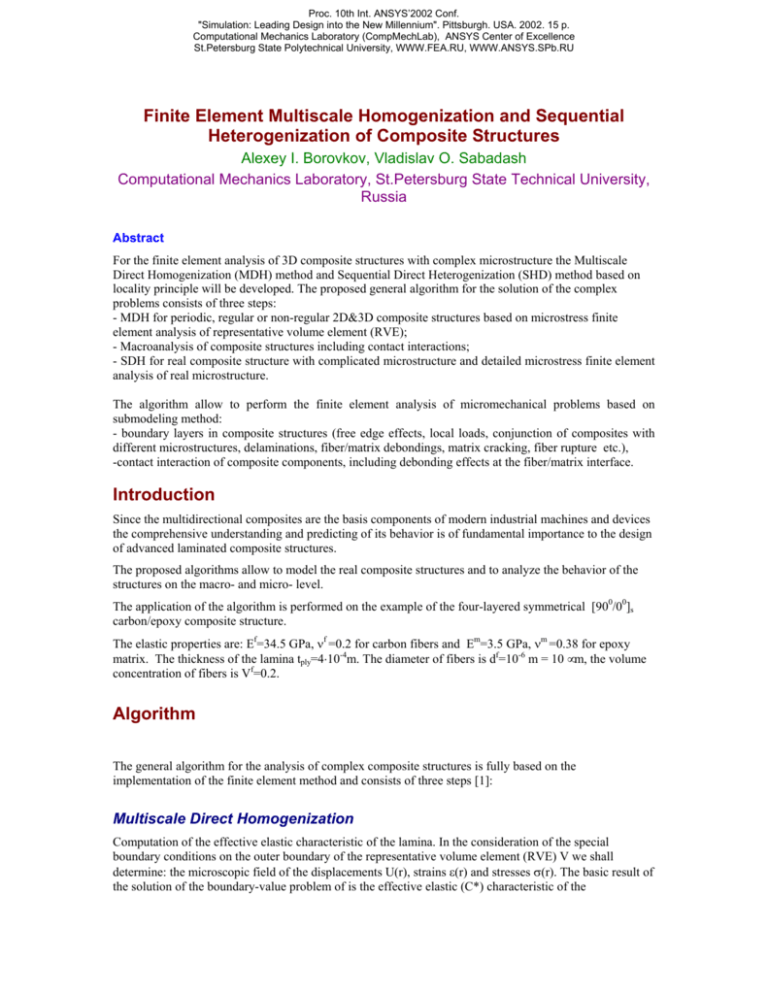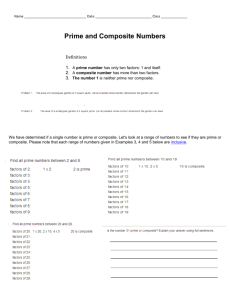Finite Element Multiscale Homogenization and
advertisement

Proc. 10th Int. ANSYS’2002 Conf. "Simulation: Leading Design into the New Millennium". Pittsburgh. USA. 2002. 15 p. Computational Mechanics Laboratory (CompMechLab), ANSYS Center of Excellence St.Petersburg State Polytechnical University, WWW.FEA.RU, WWW.ANSYS.SPb.RU Finite Element Multiscale Homogenization and Sequential Heterogenization of Composite Structures Alexey I. Borovkov, Vladislav O. Sabadash Computational Mechanics Laboratory, St.Petersburg State Technical University, Russia Abstract For the finite element analysis of 3D composite structures with complex microstructure the Multiscale Direct Homogenization (MDH) method and Sequential Direct Heterogenization (SHD) method based on locality principle will be developed. The proposed general algorithm for the solution of the complex problems consists of three steps: - MDH for periodic, regular or non-regular 2D&3D composite structures based on microstress finite element analysis of representative volume element (RVE); - Macroanalysis of composite structures including contact interactions; - SDH for real composite structure with complicated microstructure and detailed microstress finite element analysis of real microstructure. The algorithm allow to perform the finite element analysis of micromechanical problems based on submodeling method: - boundary layers in composite structures (free edge effects, local loads, conjunction of composites with different microstructures, delaminations, fiber/matrix debondings, matrix cracking, fiber rupture etc.), -contact interaction of composite components, including debonding effects at the fiber/matrix interface. Introduction Since the multidirectional composites are the basis components of modern industrial machines and devices the comprehensive understanding and predicting of its behavior is of fundamental importance to the design of advanced laminated composite structures. The proposed algorithms allow to model the real composite structures and to analyze the behavior of the structures on the macro- and micro- level. The application of the algorithm is performed on the example of the four-layered symmetrical [900/00]s carbon/epoxy composite structure. The elastic properties are: Ef=34.5 GPa, νf =0.2 for carbon fibers and Em=3.5 GPa, νm =0.38 for epoxy matrix. The thickness of the lamina tply=4⋅10-4m. The diameter of fibers is df=10-6 m = 10 µm, the volume concentration of fibers is Vf=0.2. Algorithm The general algorithm for the analysis of complex composite structures is fully based on the implementation of the finite element method and consists of three steps [1]: Multiscale Direct Homogenization Computation of the effective elastic characteristic of the lamina. In the consideration of the special boundary conditions on the outer boundary of the representative volume element (RVE) V we shall determine: the microscopic field of the displacements U(r), strains ε(r) and stresses σ(r). The basic result of the solution of the boundary-value problem of is the effective elastic (C*) characteristic of the Borovkov A.I., Sabadash V.O. Finite element multiscale homogenization and sequential heterogenization of composite structures Computational Mechanics Laboratory (CompMechLab), ANSYS Center of Excellence St.Petersburg State Polytechnical University, WWW.FEA.RU, WWW.ANSYS.SPb.RU microheterogeneous anisotropic media (macroscopic effective properties of the equivalent homogeneous media) and tensors of effective surface strength (2F*, 4F*) on the base of the prescribed microstructure of the RVE and known properties of composite’s components, that is formulation of the effective constitutive equations: <σ>=C*⋅⋅<ε>; <…>=1/V ∫ ...dV V and formulation of the effective tensor-polynomial strength Tsai –Wu criterion: f=2F*⋅⋅σ*+σ*⋅⋅4F*⋅⋅σ*+…=1, where σ* - tensor of effective (macroscopic) stresses. The dimensions of the RVE are: d=10-6 m, L=2⋅10-6 m (see Figure 1). Figure 1 - RVE dimensions The direct homogenization method [1] procedure for described composite lamina follows: * The calculation of the effective Young’s modulus E3 by using the volume concentrations: E3* = E3f ⋅ V f + E3m ⋅ (1 − V f ) . Two problems (See Figure 2 for the “Problem 1” definition and Figure 3 for the “Problem 2”) for the * * transverse tension of composite element must be solved to calculate the effective Young’s moduli E1 , E 2 and Poisson’s ratios Boundary conditions for the “Problem 1”: x1 = 0.5h1 : u1 = u10 , σ 12 = 0 ; x1 = 0 : u1 = 0 , σ 12 = 0 ; x 2 = 0.5h 2 : u 2 = 0 , σ 12 = 0 ; x 2 = 0 : u 2 = 0 , σ 12 = 0 ; Borovkov A.I., Sabadash V.O. Finite element multiscale homogenization and sequential heterogenization of composite structures Computational Mechanics Laboratory (CompMechLab), ANSYS Center of Excellence St.Petersburg State Polytechnical University, WWW.FEA.RU, WWW.ANSYS.SPb.RU Figure 2 - Homogenization Problem #1 Boundary conditions for the “Problem 2”: x1 = 0.5h1 : u1 = 0 , σ 12 = 0 ; x1 = 0 : u1 = 0 , σ 12 = 0 ; x 2 = 0.5h 2 : u 2 = u 20 , σ 12 = 0 ; x 2 = 0 : u 2 = 0 , σ 12 = 0 ; Figure 3 - Homogenization Problem #2 As results, we obtain: ∇ ⋅ (C ⋅ ∇u ) = 0 C = C ijkl ei e j ek el < ε (1) >= ε 110 e1e1 , < σ (1) >=< σ ij(1) ei e j > ; 0 < ε ( 2 ) >= ε 22 e2 e2 , < σ ( 2) >=< σ ij( 2 ) ei e j > . Borovkov A.I., Sabadash V.O. Finite element multiscale homogenization and sequential heterogenization of composite structures Computational Mechanics Laboratory (CompMechLab), ANSYS Center of Excellence St.Petersburg State Polytechnical University, WWW.FEA.RU, WWW.ANSYS.SPb.RU The system of equation follows: (1) (1) E1*ε 110 =< σ 11(1) > −ν 12* < σ 22 > −ν 13* < σ 33 > * (1) (1) * (1) 0 = −ν 21 < σ 11 > + < σ 22 > −ν 23 < σ 33 > * * (1) (1) 0 = −ν 31 < σ 11(1) > −ν 32 < σ 22 > + < σ 33 > ( 2) * ( 2) * (1) 0 =< σ 11 > −ν 12 < σ 22 > −ν 13 < σ 33 > * 0 * ( 2) ( 2) * ( 2) E 2 ε 22 = −ν 21 < σ 11 > + < σ 22 > −ν 23 < σ 33 > * * ( 2) 0 = −ν 31 < σ 11( 2) > −ν 32 < σ 22 > + < σ 33( 2 ) > * * * * E 2ν 32 = E3ν 23 E *ν * = E *ν * 1 31 3 13 The expression E 3ν 13 = E1 ν 31 ; E 2ν 32 = E3ν 23 are used, the relation E1 ν 21 = E 2ν 12 can be proved * * * * * * * * * * * * with Betty’s reciprocity theorem. The solution of the system [1,2] are: E1* = E3* a122 E3* a122 * ; ; E = 2 2 0 E3* < σ 12( 2 ) > a12 ε 110 + a 23 E3* < σ 11(1) > a12 ε 22 + a132 ν 12* = (1) E3* < σ 11( 2 ) > a 21 − E1* < σ 33( 2 ) > a 23 E3* < σ 22 > a12 − E1* < σ 33(1) > a13 * ν ; ; = 21 ( 2) (1) E3* < σ 22 > a 21 E3* < σ 22 > a 21 * ν 23 = E 2* a13 E1* a 23 a13 a * * * ; ν ; ν ; ν 31 = 23 ; = = 13 32 * * a12 a 21 E3 a12 E3 a 21 aij =< σ ii(1) >< σ (jj2) > − < σ (jj1) >< σ ii( 2 ) > , (no sum for i,j). When the problem of the transverse shear of composite element in plane strain is solved: x1 = 0.5h1 : u 2 = 0 , σ 11 = 0 ; x1 = 0 : u 2 = 0 , σ 11 = 0 ; x 2 = 0.5h 2 : u1 = u10 , σ 22 = 0 ; x 2 = 0 : u1 = 0 , σ 22 = 0 ; * the effective shear modulus G12 can be calculated: G12* = u10 < σ 12 > , where < γ 12 >= . < γ 12 > h2 2 * * To calculate the effective shear moduli G 23 and G31 two anti-plane strain (as the steady-state thermal analogy) problems for RVE should be solved. * The problem for G12 evaluation: x1 = 0.5h1 : , σ 13 = 0 ; x1 = 0 : , σ 13 = 0 ; Borovkov A.I., Sabadash V.O. Finite element multiscale homogenization and sequential heterogenization of composite structures Computational Mechanics Laboratory (CompMechLab), ANSYS Center of Excellence St.Petersburg State Polytechnical University, WWW.FEA.RU, WWW.ANSYS.SPb.RU x 2 = 0.5h 2 : u 3 = u 30 ; x 2 = 0 : u 3 = 0 ; * G23 = < σ 23 > u 30 , where < γ 23 >= . < γ 23 > h2 2 * The problem for G31 evaluation: x1 = 0.5h1 : , u 3 = u 30 ; x1 = 0 : u 3 = 0 ; x 2 = 0.5h 2 : σ 23 = 0 ; x 2 = 0 : σ 23 = 0 ; * = G31 < σ 31 > u 30 , where < γ 31 >= . < γ 31 > h1 2 Using the this algorithm the effective material properties for the homogenized media of the lamina were calculated: E1* = 9.7 GPa ; E 2* = 5.27 GPa ; E3* = 5.27 GPa ; γ 12* = 0.34 ; * γ 23 = 0.48 ; * γ 31 = 0.48 ; G12* = 2.12 GPa ; G13* = 2.12 GPa ; * = 1.65 GPa , G23 where 1 axis is parallel to the directions of fiber. Macroanalysis Finite element solution of the thermo-mechanical problems. We shall compose the FE-model of the real macroheterogeneous composite structure where the basic component is macroscopic homogeneous anisotropic media with the effective properties determined earlier. Taking into account prescribed boundary conditions we shall determine: macroscopic fields of temperature T*(r*,t), displacements u*(r*), strains ε*(r*) and stresses σ*(r*). After the determination of the effective stress tensor σ*(r*) with the use of effective tensor-polynomial strength criterion we shall determine we shall determine the part of the structure with critical macroscopic stresses. These parts needs to be analyzed taking into account real microheterogeneous structure of composite. Lets consider the laminated composite plate (see Introduction) subjected by σx longitudinal tension load. The effective material properties are calculated by direct homogenization algorithm. Due to the symmetry only 1/8th part of the structure is modeled (Figure 4). Figure 5 shows the used FE model. The stress Borovkov A.I., Sabadash V.O. Finite element multiscale homogenization and sequential heterogenization of composite structures Computational Mechanics Laboratory (CompMechLab), ANSYS Center of Excellence St.Petersburg State Polytechnical University, WWW.FEA.RU, WWW.ANSYS.SPb.RU distributions for this structure are shown in following figures: σx – Figure 6, σy – Figure 7, σz – Figure 8, σvon Mises – Figure 9. Figure 4 - The view of the crossply laminated composite BC Figure 5 - The view of the crossply laminated composite FE model Figure 6 - The view of the σx stress distribution for the macroanalysis Borovkov A.I., Sabadash V.O. Finite element multiscale homogenization and sequential heterogenization of composite structures Computational Mechanics Laboratory (CompMechLab), ANSYS Center of Excellence St.Petersburg State Polytechnical University, WWW.FEA.RU, WWW.ANSYS.SPb.RU Figure 7 - The view of the σy stress distribution for the macroanalysis Figure 8. The view of the σz stress distribution for the macroanalysis Figure 9. The view of the σMises stress distribution for the macroanalysis Borovkov A.I., Sabadash V.O. Finite element multiscale homogenization and sequential heterogenization of composite structures Computational Mechanics Laboratory (CompMechLab), ANSYS Center of Excellence St.Petersburg State Polytechnical University, WWW.FEA.RU, WWW.ANSYS.SPb.RU This type of mechanical loading produce interlaminar stresses especially near the free edges (Figure 3). Normal tensile interlaminar stresses, or peel stresses, tend to separate the laminate from each other. Interlaminar shear stresses tend to slide one lamina over adjacent one. Both these types of stresses can cause interlaminar separation or in other words delamination [5]. The proposed FE model allows to easily estimate the interlaminar stresses but these stresses do not directly correspond to the real stresses in the fibers and matrix since they are obtained for some media with effective properties. So the mathematical and computational apparatus is needed to zoom into the composite microstructure. We cannot model the whole composite with the required for deriving the microstresses values detailing level but we can model the microstructure of the composite selectively. The locality principle validates the reliability of this approach. Locality principle Formulation of the locality principle: effect of homogenization of the part of structure has influence on the homogenized part not farther than n characteristic length of cell d. The first formulation and application of the locality principle can be found in [3]. Taking into account this principle it is possible to model microstructure only in small region near the zone of interest (for example the crack tip or any other stress concentration) and to model the rest of the structure with homogenized material [4]. The locality principle is the basis for the sequential heterogenization procedure, which is described below. The demonstration of the locality principle is performed on the example of the plain strain 2D FE analysis of the fiber composite lamina. The FE mesh and the σx distribution for direct finite element modeling are shown in Figure 10. The FE mesh and the σx distribution for FE modeling of the partially homogenized structure modeling are shown in Figure 11. The comparison of these results is shown in Figure 12. Figure 10 - The view of the exact solution FE mesh and σx stress distribution Borovkov A.I., Sabadash V.O. Finite element multiscale homogenization and sequential heterogenization of composite structures Computational Mechanics Laboratory (CompMechLab), ANSYS Center of Excellence St.Petersburg State Polytechnical University, WWW.FEA.RU, WWW.ANSYS.SPb.RU Figure 11 - The view of the SDH solution FE mesh and σx stress distribution Sequential Direct Heterogenization Figure 12. The comparison of the exact and SDH solutions Borovkov A.I., Sabadash V.O. Finite element multiscale homogenization and sequential heterogenization of composite structures Computational Mechanics Laboratory (CompMechLab), ANSYS Center of Excellence St.Petersburg State Polytechnical University, WWW.FEA.RU, WWW.ANSYS.SPb.RU Finite element solution of the microthermomechanical problems. We shall construct FE models of RVE of the microheterogeneous media or the fragments of the real composite structure. It should be noted that the sequential heterogenization procedure could be performed in each zone. After the solution of the boundaryvalue problems with the boundary conditions based on the macroscopic variables, we shall determine real microscopic fields T(r), u(r), ε(r), σ(r). During this step we are analyzing the concentration of microstresses in zones with fast changing geometry of the microstructure, on the surfaces of composite’s components conjunction and in any zone which is interesting for analyst (for example, boundary layers zones). The FE model used in sequential direct heterogenization run is shown on Figures 13 and 14. Figure 13 - The view of the submodel FE model Figure 14 - The close view of the submodel FE model The disposition of the submodel in the body of homogenized composite is shown in Figure 14. The submodel consists of two fractions: homogenized media (the same as in macroanalisis run) and heterogenized microstructured part of the composite. Heterogenized part of the submodel is shown in Figure 15. Figure 15 - The view of the heterogenized part of submodel FE model Borovkov A.I., Sabadash V.O. Finite element multiscale homogenization and sequential heterogenization of composite structures Computational Mechanics Laboratory (CompMechLab), ANSYS Center of Excellence St.Petersburg State Polytechnical University, WWW.FEA.RU, WWW.ANSYS.SPb.RU The results of the heterogenized composite FE modeling are shown in the following figures: Figure 16 - σx stress distribution in the submodel; Figure 16. The view of the σx stress distribution in the submodel Figure 17 - σy stress distribution in the submodel; Figure 17 - The view of the σy stress distribution in the submodel Figure 18 - σz stress distribution in the submodel; Figure 18 - The view of the σz stress distribution in the submodel Borovkov A.I., Sabadash V.O. Finite element multiscale homogenization and sequential heterogenization of composite structures Computational Mechanics Laboratory (CompMechLab), ANSYS Center of Excellence St.Petersburg State Polytechnical University, WWW.FEA.RU, WWW.ANSYS.SPb.RU Figure 19 - σvon Mises stress distribution in the submodel. Figure 19. The view of the σMises stress distribution in the submodel The objective of direct sequential heterogenization implementation in this work is to obtain the microstresses values in the heterogenized part of the model: Figure 20 - σx stress distribution in the heterogenized part; Figure 20 - The view of the σx stress distribution in the heterogenized part Figure 21 - σy stress distribution in the heterogenized part; Figure 21 - The view of the σy stress distribution in the heterogenized part Borovkov A.I., Sabadash V.O. Finite element multiscale homogenization and sequential heterogenization of composite structures Computational Mechanics Laboratory (CompMechLab), ANSYS Center of Excellence St.Petersburg State Polytechnical University, WWW.FEA.RU, WWW.ANSYS.SPb.RU Figure 22 - σx stress distribution in the heterogenized part; Figure 22 - The view of the σz stress distribution in the heterogenized part Figure 23 - σvon Mises stress distribution in the heterogenized part. Figure 22 - The view of the σz stress distribution in the heterogenized part The results for fibers presented in the following figures: Figure 24 - σx stress distribution in the fibers; Figure 24 - The view of the σx stress distribution in the fibers Borovkov A.I., Sabadash V.O. Finite element multiscale homogenization and sequential heterogenization of composite structures Computational Mechanics Laboratory (CompMechLab), ANSYS Center of Excellence St.Petersburg State Polytechnical University, WWW.FEA.RU, WWW.ANSYS.SPb.RU Figure 25 - σy stress distribution in the fibers; Figure 25. The view of the σy stress distribution in the fibers Figure 26 - σx stress distribution in the fibers; Figure 26 - The view of the σz stress distribution in the fibers Figure 27 - σvon Mises stress distribution in the fibers. Figure 27 - The view of the σMises stress distribution in the fibers Borovkov A.I., Sabadash V.O. Finite element multiscale homogenization and sequential heterogenization of composite structures Computational Mechanics Laboratory (CompMechLab), ANSYS Center of Excellence St.Petersburg State Polytechnical University, WWW.FEA.RU, WWW.ANSYS.SPb.RU Conclusion The algorithm of multiscale homogenization and sequential heterogenization of composite structures was proposed and implemented on example of [0,90]s crossply laminate. The proposed algorithm allows analyzing complex problem of the composite structures behavior by a set of sequential FEA runs even on a single PC computer with the guaranteed reliability of the results obtained. References 1) A.I. Borovkov, Effective Physical And Mechanical Characteristic of the Fiber Composites; VINITI Publ., Comp., Moscow 1985 (in Russian). 2) A.I. Borovkov, A.E. Klich, Computational Micromechanics of Composites. Finite Element Homogenization Methods //Appl.Math.Mech. (Z.Angew.Math.Mech. - ZAMM). V.78. Suppl. 1. 1998. S295-S296. 3) A. Belyaev, V. Palmov, V. Locality Principle in structural dynamics. Proc. II Conf. On Recent Advances in Structural Dynamics. Eds. M. Petyt, H.F. Wolfe. University of Southampton. U.K. 1984, 229-238. 4) A.I. Borovkov, V.A. Palmov, V.A. Locality principle in mechanics of composite structures // Preprints 3rd Int. Workshop «Nondestructive Testing and Computer Simulations in Science and Engineering» (NDTCS'99). St.Petersburg. Russia. 1999. H6-H7. 5) Isaac M. Daniel, Ori Ishai, Engineering Mechanics of Composites Materials., Oxford University Press, New York, USA, 1994.






